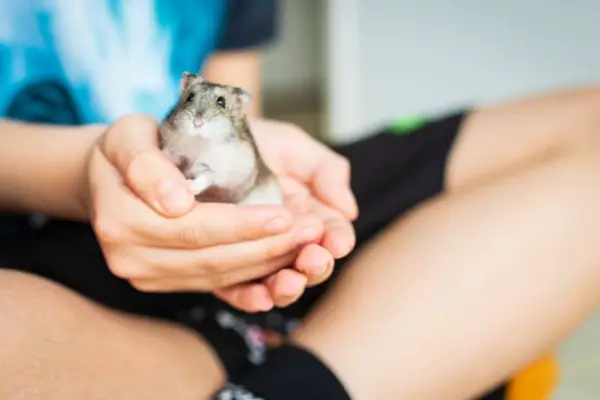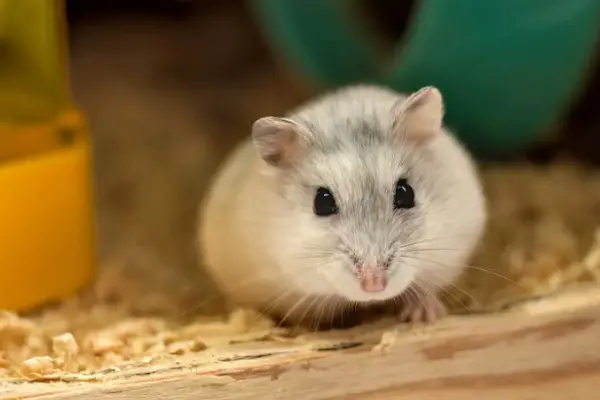18 Ways To Care For And Comfort A Dying Hamster

In this article, we will be discussing the most common ways to care for and comfort a dying hamster which you should know.
We all know that hamsters are great pets for kids, but it’s also important to address the death of these little buddies.
The death of a pet is always heartbreaking. It’s not easy to know what to do or how to comfort a grieving pet owner.
In this blog post, we’ll discuss what you need to do when your hamster passes on.
It’s important to understand the feelings you might have after your pet dies and how to comfort a dying hamster.
You want to give him a gentle, loving goodbye. Don’t worry! Here are many ways that will help you and your furry friend have a peaceful end together.
Also, check out the 11 common signs of a dying hamster you should look out for.
Ways To Care For And Comfort A Dying Hamster
Here are the common ways to care for and comfort a drying hamster, you should know which are as follows:
Providing a safer environment for your hamster
Even when they are sick, hamsters are known to exercise.
Remove any wheels, tubes, and climbing devices from their cage to avoid them from hurting themselves or burning all their reserve energy.
To keep them comfortable when they sleep, make sure they have a clean, dark space that is free of noise, draughts, and moisture.
If you already have two or three hamsters in one cage.
Separate sick hamsters into separate cages to avoid stress from other animals and activity, and to reduce the chance of illness transfer to the other hamsters.
Make a new environment for your hamster
Transfer your hamster to a new home. If you have a habitat with many hamsters, set aside a spot for your ill or dying hamster to repose.
Keeping your hamster happy, preventing stress from other animals and activity, and reducing the potential of disease transfer to cage mates may all be achieved by using an isolated environment.
Place the isolated hamster somewhere where it won’t be disturbed by other pets, family members, strong light, or noise.
Make sure the new cage you’re moving your hamster into is big enough for it to be comfortable.
Even if the hamster does not move much, it should have enough area to move around.
It’s best not to put an exercise wheel in the new environment.
When hamsters are unwell, they are known to exercise, which can lead to injury or dehydration.
Remove or plug any tunnels to keep the cage plain and welcoming. This will help your hamster move as little as possible.
More dens and hideouts should be added in the cage
Hamsters are known to love hideouts where they can stay happy playing or napping.
They like to burrow in dark corners in the woods, so an additional den or hideout will make them feel secure.
Because hamsters like creating unique sleeping areas and creating comfortable and cozy bedding.
As a responsible pet owner, you should assist your dying hamster in adding more dens for the sake of your hamster.
Clean up the old cage you moved your hamster
Clean up the old cage where your dying hamster left and make it’s free from any bacteria.
When you relocate a hamster to a new place, whether you have many hamsters or just one, it’s critical to clean the cage completely.
This can reduce disease transfer to cage mates or provide a clean and comfortable environment for a new solitary hamster.
When cleaning up, put on protective gloves or thoroughly wash your hands after cleaning and apply disinfectant.
As much as possible, avoid dehydration
The lack of hunger and thirst are two of the first symptoms that your hamster is dying. Their bodies start malfunctioning as time goes by.
They don’t experience the sensations of hunger or thirst any longer.
Dehydration may make hamsters feel uneasy and perhaps lead them to die in a painful manner.
Provide your hamster with meals that are rich in moisture, such as watermelon, cucumber, or apples.
Make sure the apple is peeled and the watermelon and cucumber seeds are removed.
Remove the bottle from the cage, take him up, and gently push the bottle into their mouth to “nurse” him.
In the new environment, keep your hamster warm
Maintain a temperature of 69°F to 72°F (20°C to 22°C) in the room where they are heated.
They will enter a condition of hibernation if the indoor temperature falls below 60 degrees Fahrenheit (15 degrees Celsius).
Fill their enclosure with simple, unscented torn toilet paper.
This will not only give them a cozy bed to sleep in, but it will also keep them warm.
Keeping your hamster warm, but not too hot, can keep it comfortable and reduce any stress it may be experiencing.
More liquids should be supplied
Provide adequate liquids for your dying hamster; obtaining enough liquids is more important than getting enough food.
Keeping your hamster hydrated may be as simple as making sure it has access to fresh water and feeding it meals that are high in water.
Recognize that water is your hamster’s best source of liquid. You may also feed it a diluted electrolyte solution with no flavor.
As directed by a competent veterinarian, combine one part electrolyte solution to one part water.
Increase your hamster’s liquid intake by adding fruits like pears and apples. Even a slice of milk-soaked bread will supplement its fluid intake.
Warmth and comfort are provided by holding your hamster
For warmth and comfort in your final days on Earth, hold your hamster.
Wrap your hamster in a tiny towel and hold it close to your body if it is comfortable and not fighting you.
This is a wonderful way to spend some quality time with your hamster who is dying. This method will only work if your hamster enjoys being held.
While the towel and your body heat thaw it up, the hamster may snuggle up and sleep on you.
Avoid placing your hamster near a window in direct sunlight. Instead, pick a shady and well-ventilated location of your home.
If your hamster permits it, stroke it. You may even sing to it or chat to it. This will help to calm and relax your hamster.
Allow your hamster to consume a little food at a time
Allowing your hamster to consume too much at once is not a good idea.
Allow your hamster to eat for a few minutes if it appears hungry.
After that, take a pause and attempt feeding or providing additional food to it.
Allowing your hamster to eat without a pause might aggravate its sickness and make it feel much worse.
Food and water bowls should be replaced in your hamster’s cage
Food and water bowls should be replaced for your hamster regularly.
Wash your hamster’s food and water bowls with hot, diluted, soapy water if you haven’t previously.
After completely drying them, provide new food and water.
This will reduce the chances of your hamster being sicker and may even increase its appetite to eat.
When washing your hamster’s food and water bowls, avoid using bleach. Your hamster might be poisoned by leftover bleach.
Place your hamster’s food and water bowls nearby
Place your hamster’s food and water bowls near together. When hamsters are sick, they become sluggish and stop eating.
To combat sickness and recuperate, they must eat and drink on a regular basis.
Bringing your hamster’s food and water bowls closer to it allows it to eat and drink while reducing movement.
Place the dishes in close proximity to your hamster’s home.
This makes it easy for your hamster to get from its warm place to the food and water it requires.
Hand-feed or syringe-feed your hamster
You can feed your hamster by hand or with a syringe if it doesn’t seem to be eating or drinking from its bowls.
This could be a better option for your hamster than changing to a new dish. It can also supply drinks and nutrients.
Place food scraps in your hands and see if your hamster will eat them. You might want to do this while sitting in a comfortable position to allow your hamster to eat.
Stroke and chat to your hamster to make it feel safe and secure.
Place the syringe behind the front teeth at the corner of the mouth.
Then press down on the plunger. Your hamster could even pick up the syringe and feed itself.
Protein should be increased in the diet of your hamster
Boost your hamster’s protein intake since proteins can aid in the development of strength in your hamster.
Including some delicious, protein-rich items in your hamster’s diet may aid in its recovery from sickness.
When feeding your hamster with high-protein foods, remember to wash the dishes as needed.
Medications for pain relief should be available
You need to make life easier for your dying hamster by whatever means possible, even if it is pain relief medication.
This technique is necessary to keep your hamster comfortable in his final days, but only provide medication that has been recommended by a licensed veterinarian.
If you self-prescribe, you risk exacerbating the problem and making them feel worse.
Keep an eye out for symptoms of sickness that occur frequently
Keep an eye out for any early indications of sickness. When a hamster is sick or dying, he or she will generally show one or more minor physical indications.
Observing your hamster(s) on a regular basis can help you spot possible issues, provide comfort, and seek veterinarian assistance if the symptoms do not improve within a few days.
Keep an eye out for symptoms of serious sickness or death. Some hamsters may show signs of disease or death that are more alarming.
Make an appointment with your veterinarian
Take your hamster to the vet if it doesn’t respond to your attempts to make it comfortable and keep it nourished and hydrated.
Finding the right therapy in a timely manner may be crucial to your hamster’s recovery.
Keep an eye out for symptoms of illness or death in your pet’s behavior
Keep an eye out for behavioral indicators of sickness or death.
It’s vital to pay attention to your hamster’s behavior in addition to its physical appearance.
Although it may not show outward signs of sickness, a hamster’s behavior might alert you to the possibility of illness or death.
Pay more attention to your dying hamster
Despite their origins as solitary creatures, hamsters may establish relationships with their human partners.
Your firm may provide comfort and security to people as they approach death.
In whatever way you can, spoil your hamster. If they require it, you can clean their butts using baby wipes.
Obtain your hamster’s favorite treats and snuggle with them.
Excessive holding, on the other hand, might cause your hamster to lose energy and become too tired.
Recommend topics about hamsters:
- Why Is My Hamster Drinking So Much Water: 7 Common Causes.
- Why Is My Hamster Not Drinking Water: 8 Common Reasons.
- Why Is My Hamster Sleeping At Night: 9 Common Reasons.
- Are Hamsters Dangerous: 12 Bad Things About Hamsters.
Wrapping up on ways to care for and comfort a dying hamster
Your hamster isn’t feeling well. You’ve noticed that it’s stopped eating, and its eyes are glazed over.
It’s breathing shallowly, and you can no longer feel a heartbeat. Your hamster is dying.
First off, don’t panic!
The first thing you need to do is give your hamster lots of love and attention.
Then, make sure it has easy access to fresh water and food (if it still wants to eat).
Try providing your pet with some new toys to get them excited about living again.
The most important thing when caring for a dying pet is making the animal as comfortable as possible in its final hours or days.






